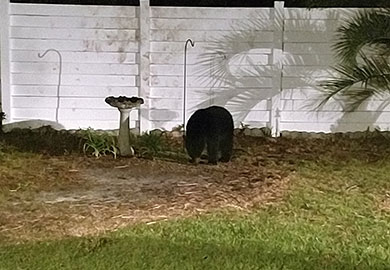May 13, 2019

A bear in one of South Carolina's northern coastal counties raids a homeowner's bird feeder. [photo by Kathy Beck courtesy SCDNR]
Bear sightings in the fast-growing northern coastal counties of South Carolina are on the increase, and a state wildlife biologist says it's due to habitat loss.
Bear sightings during the spring and summer are old news for residents of the South Carolina Upstate, and long-time residents of South Carolina’s most mountainous counties have learned to adjust, taking down backyard bird feeders during the busiest times of the year, securing their garbage in bear-proof containers and employing other strategies to keep these animals from getting to comfortable around neighborhoods that border on wild areas. That may be “old hat” for folks in rural Pickens or suburban Greenville, but the issue affects people in some of our fast-growing coastal counties as well, according to Kayla Brantley, an SCDNR wildlife biologist who studies South Carolina’s coastal black bear population.
’One of the things we are finding down here on the coast is that habitat loss is an issue,” said Brantley, “so sightings and calls to our office are definitely on the increase.”
While “transient” bears have been sighted in nearly every county in the state, SCDNR biologists believe that “sustainable” year-round populations exist across both Horry and Georgetown counties, as well as parts of Berkeley, Dillon, Marion, Williamsburg, Dorchester and Charleston counties. Some parts of the estimated total range for the coastal bear population is wild and largely uninhabited, but in this fast-growing region of the state, it was inevitable that in some places new development would bring residents into the bears’ proximity.
If you would like to report a bear sighting, please use the online form that can be found at: /wildlife/species/bear.html.
This information is an ideal tool to capture these reports, as it will help biologist identify possible home range expansions, nuisance problems, etc. all of which assist with the black bear management.
It is not necessary to call an SCDNR Office with every sighting of a bear, but in an emergency situation, residents can always reach the SCDNR Dispatch Office at 1-800-922-5431 (the Operation Game Thief hotline), or dial 9-1-1 to reach first responders in their local area. Road-killed bears should be reported by calling the OGT line.
Black bears’ natural diet consists of berries, nuts and plant matter (over 80 percent) as well as insects and meat (less than 20 percent). However, they are also opportunistic and will feed on whatever is readily available. Bears use their incredible sense of smell to find alternative food sources such as garbage, bird feeders, outdoor pet food, agricultural crops, etc., which can result in them becoming nuisance bears. It is illegal to intentionally put out food to attract bears, said Brantley, and if that activity is suspected, it can also be reported to the SCDNR hotline number. While people may be excited about seeing a bear, biologists urge them to remember that bears are wild animals and should be respected. Black bears are usually shy, evasive and non-aggressive toward people. Neither a human fatality nor even an attack have been attributed to a black bear in South Carolina.
Coastal residents in "bear country" may have to adapt to the same tactics that their Upstate counterparts have been employing for years. Those include:
- Bird feed and feeders: If you are aware of a bear being in your area, go ahead and remove your bird feeder for at least two weeks; the bear will move on quickly.
- No garbage: Keep garbage in tightly shut or bear-proof trash cans; garbage left in the open, in an open dumpster, or in the back of a truck is an open invitation for a bear.
- Pet food storage: Store pet food properly if kept outside; put pet food in airtight storage containers and don't leave leftover food out in the open.
- Clean grills: Keep charcoal and gas grills covered and clean to keep food odors from attracting bears.
- Beehives: If you're going to have beehives in bear territory, protect your investment with an electric, bear-proof fence.
- No feeding: A bear that becomes accustomed to having food provided is an accident waiting to happen; don't feed a bear the first time and it will likely leave the area soon.
Bear activity increases this time of the year and homeowners should be mindful of the attractants (bird feeders, trashcan, grill, etc.) they may have. One of the biggest problems we face on the coast is birdfeeders. If you have a birdfeeder and there has been a bear sighting reported in your area, go ahead and remove the birdfeeder for at least two weeks. If there hasn’t been a sighting reported after two weeks, then you may put your bird feeder out again if you wish. In some cases, the birdfeeder may have to be removed once again. Overall, if you remove that attractant, the bear will move on.



